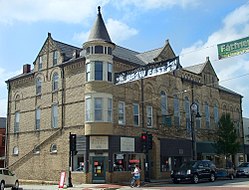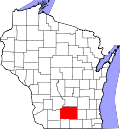2010 census
As of the census [3] of 2010, there were 7,011 people, 2,696 households, and 1,878 families residing in the village. The population density was 2,156.6 inhabitants per square mile (832.7/km2). There were 2,826 housing units at an average density of 869.5 per square mile (335.7/km2). The racial makeup of the village was 96.0% White, 0.8% African American, 0.2% Native American, 0.6% Asian, 0.5% from other races, and 1.8% from two or more races. Hispanic or Latino of any race were 1.7% of the population.
There were 2,696 households, of which 41.6% had children under the age of 18 living with them, 56.5% were married couples living together, 9.5% had a female householder with no husband present, 3.7% had a male householder with no wife present, and 30.3% were non-families. 24.4% of all households were made up of individuals, and 10.2% had someone living alone who was 65 years of age or older. The average household size was 2.56 and the average family size was 3.09.
The median age in the village was 35.5 years. 29.5% of residents were under the age of 18; 5.8% were between the ages of 18 and 24; 29.1% were from 25 to 44; 24.1% were from 45 to 64; and 11.4% were 65 years of age or older. The gender makeup of the village was 47.9% male and 52.1% female.
2000 census
As of the census [5] of 2000, there were 5,860 people, 2,228 households, and 1,544 families residing in the village. As of 2010 there are 7,009 people. The population density (in 2000) was 2,011.5 people per square mile (777.5/km2). There were 2,305 housing units at an average density of 791.2 per square mile (305.8/km2). The racial makeup of the village was 98.28% White, 0.22% African American, 0.24% Native American, 0.31% Asian, 0.09% Pacific Islander, 0.34% from other races, and 0.53% from two or more races. Hispanic or Latino of any race were 0.58% of the population. 33.0% were of German, 22.6% Norwegian, 10.7% Irish, 5.8% English and 5.2% American ancestry according to Census 2000.
There were 2,228 households, out of which 38.8% had children under the age of 18 living with them, 57.1% were married couples living together, 9.5% had a female householder with no husband present, and 30.7% were non-families. 24.3% of all households were made up of individuals, and 10.5% had someone living alone who was 65 years of age or older. The average household size was 2.56 and the average family size was 3.07.
In the village, the population was spread out, with 28.8% under the age of 18, 6.8% from 18 to 24, 34.0% from 25 to 44, 17.4% from 45 to 64, and 13.0% who were 65 years of age or older. The median age was 34 years. For every 100 females, there were 91.3 males. For every 100 females age 18 and over, there were 86.8 males.
The median income for a household in the village was $55,513, and the median income for a family was $63,234. Males had a median income of $40,850 versus $27,391 for females. The per capita income for the village was $23,359. About 0.8% of families and 3.1% of the population were below the poverty line, including 2.0% of those under age 18 and 9.0% of those age 65 or over.





